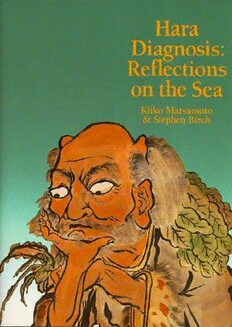
Hara Diagnosis: Reflections on the Sea PDF
Preview Hara Diagnosis: Reflections on the Sea
Hara Diagnosis: Reflections on the Sea Hara Diagnosis: Reflections on the Sea - by - Kiiko Matsumoto & Stephen Birch Paradigm Publications • Brookline, Massachusetts - 1988 - Published by Paradigm Publications 44 Linden Street Brookline, Massachusetts, 02146 U.S.A. ISBN0-912111-13-5 Copyright© 1988KiikoMatsumotoand StephenBirch All rightsreserved. Nopart of thispublicationmaybe reproduced,storedin a retrievalsystemor transmittedin any form by any means, electronic,mechanical,photocopying,recording,or otherwise,without the prior written permis sion of the publisher. LibraryofCongress Catalogingin Publication Data: Matsumoto,Kiiko. Haradiagnosis. Bibliography:p. Includesindex. 1.Medicine,Chinese. 2.Medicine,Chinese-Japan. 3.Abdomen—Examination.4.Palpation.I.Birch, Stephen.II.Tide.[DNLM: 1.Abdomen.2.Diagnosis. 3.MedicineOrientalTraditional.4.Palpation- methods. WB275M434h] R602.M36 1988 616.07'54 88-17955 ISBN0-912111-13-5 ParadigmPublications Publisher:RobertL.Felt Editor:MarthaLeeFielding CoverIllustration:YoshioManaka TextIllustration&CoverDesign:HerbRichIII FormattingSupervisor:T.DianePutt TypesettingSoftware: TextwareInternational,Cambridge,Massachusetts ChineseCharacterTypesetting: LinguisticSystems,Cambridge,Massachusetts AdditionalSoftware& WorldDistribution provided by RedwingBookCompany,Brookline,Massachusetts Acidfree,archive-qualitypapershavebeenused intheproductionofthistexttoinsurelongevity. Coverillustrationfromascroll byYoshioManaka, depicting ShenNung, thefatherofChinesemedicine. Acknowledgements Acknowledgements Iwish to extendmydeepestgratitutde to Sensei Kuzome, for teaching me the essenceof his styleof abdominal diagnosis;and to SenseiYoshio Manaka, for his generoussharingof his greatknowledgeand research,and for hisboundless inspiration. My deepest gratitude is extended to Soshichiro Tobe and Yuichiro Tobe,ofIdoNoNipponSha,for theirunflaggingassistanceand encourage mentgiventomeoverthemanyyearsofmyfriendship with them. I also thank my colleague, Stephen Birch, for his unremitting efforts and exhaustive research, without which this book might not have been completed. I dedicate this book to the memory of my dear father, Tojiro Matsumoto. Kiiko Matsumoto Natick, Massachusetts. (cid:143) Acknowledgements * * * The work involved in translating, compiling, researching, writing, and rewriting this book has been considerable. It would have been much slowerand moredifficultorperhaps impossiblewithoutthekind helpand contributions of many people. Firstand foremost are my teachersand friends Dr.Jim Oschman and Dr. Yoshio Manaka. Dr. Oschman provided considerable support and enthusiasm, with numerous articles, references, ideas, and brainstorms. Hisknowledgeand wisdom is quite somethingto encounter. Dr.Manaka shared his knowledge and clinical experiences with me by hosting my study-visitto his clinicin Japan. His papers, books, questions, answers, discussions,experiments,clinicaldemonstrations,and greatkindness have profoundly influenced my work and much of my contribution to this book. Ithas been my heartfeltpleasure tq facilitate a greaterpromulgation of the ideas of these two remarkable individuals throughout the pages of thiswork. Mydebt toboth ofthem isconsiderable. My family and close friends provided much-needed emotional sup port;Ithank them for "puttingup" withme,especiallymyparents,mysis ter Helen,and friends such asJunko, Rick, Marty, April,Natalie, and Tim. BobFelt,MarthaFielding, DianePutt,and HerbRichshowedgreatpatience and perseverance working on this text; their advice and our exchanges alwaysproved fruitful. I would like to thank Dr. Victor Penzer and Dr. RobertSampson for their useful feedback; and Dr. Paul Zmiewski for his technical and transla- tional assistance with the bibliography. My students and patients issued numerous challengesfor which Iam alsogratefulas a learningexperience. Icannot begin to mention everyoneby name without leavingsome out, the support I have had and found has been extensive,I am indebted to many more than mentioned above. Kiiko Matsumoto's tireless dedication and committment to the materi alspresented in this book provided the essential foundation for our work. Ithasbeen mygreatpleasuretoexpand and buildupon thatfoundation. Perhaps the most continuous debt I have is to my inspirational teach ers, the great masters of the past, Johann Sebastian, WolfgangAmadeus, George Frideric, FranzJoseph, Antonio, Georg Philippet al. Their works havehelped generate the focus necessary for thisbook. Lastbut not least, the debt we have to the geniuses of ancient China andthegenerations ofpractitioners andscholars fromChinaandJapancan neverbe forgotten. Stephen Birch Cambridge,Massachusetts (cid:143) Table of Contents Introduction 1 Chapter One:The Hara 7 ChapterTwo: Palpation 15 Usesof Palpation 18 Acupoints&BodyLandscape 20 PalpationinClassicalLiterature 21 ExtrapolatingfromtheClassicalTexts 25 PalpationSystems 26 Chapter Three: Spiritual, Mental, and Emotional Aspects ofChinese Medicine 31 Chapter Four: InternalTrajectories ofthe Twelve Meridians 47 InternalTrajectoriesoftheLungMeridian 51 InternalTrajectoriesoftheLargeIntestineMeridian 53 InternalTrajectoriesoftheStomachMeridian 53 InternalTrajectoriesoftheSpleenMeridian 54 InternalTrajectoriesoftheHeartMeridian 54 InternalTrajectoriesoftheSmallIntestineMeridian 55 InternalTrajectoriesoftheBladderMeridian 56 IntemalTrajectoriesoftheKidneyMeridian 56 InternalTrajectoriesofthePericardiumMeridian 58 InternalTrajectories oftheTripleWarmerMeridian 62 InternalTrajectories oftheGallbladderMeridian 63 InternalTrajectoriesoftheLiverMeridian 64 Chapter Five: Origins and Energetics 67 Transformations 86 Chapter Six: SourceTheory 95 LingShuSourceTheory 97 AnatomicalRelationships 106 NanJingSourceTheory 108 Chapter Seven: Classical Energetic Anatomy& Physiology 131 Sources& Myths 133 The Huang,Gao,and TripleWarmer 135 TheMoand Luo 141 Muscles& Membranes 148 EmbryologicalDevelopment 153 (cid:143) Table ofContents viii Chapter Eight:Modern Anatomyand Physiology ofthe Fasciae and ConnectiveTissues 157 TheFascialSystem 160 FascialConnections 161 TheFasciaeinEmbryology 165 EmbryologicalDevelopmentoftheMeridianSystem 174 AnElectrodynamicModeloftheTripleWarmer 189 Dantian 190 RelationshipstoPhysicalPrinciples 191 MeridianSystems 193 Electricaland MagneticFieldEffects 197 Summary 200 Chapter Nine: Science Revisited 203 ElectricalPropertiesofAcupunctureSystems 206 ElectricalPropertiesofMoxibustion 213 PhysiologicalEffectsofFingerPressureandMassage 214 ClinicalPerspectives onAbdominalPalpation 214 Integration 216 ChronobiologicalEffects 216 ModelsofEnvironmentalInfluences 221 SensorialCorrespondences and PossibleFieldEffects 224 PhaseEffectsina FieldModel 228 Summary 232 ChapterTen: Integration and Differentiation: Clinical Perspectives 237 TheHealthyHara 244 ClinicalApproaches 245 Chapter Eleven: HaraDiagnosis in Practice 247 DifferentiationofAbdominalFindings 249 SignificantReactions 250 SignificantFindings 251 DiagnosticProcedure 255 CommonPatternsofAbdominalReactions 259 AbdominalDifferentialDiagnosis 262 Summary 267 ChapterTwelve: HaraShiatsu 269 GeneralTreatmentProcedure 275 SpecialTreatmentTechniques 276 SubsternalRegion 278 MedialSupra-umbilicalRegion 281 SubsternalRegiontoUmbilicalRegion 283 Supra-umblicalRegion 283 Supra-umbilicalRectusAbdominusRegions 284 FluidAccumulationintheStomach 286 SubcostalRegion 287 EpigastricRectusAbdominus Region 290 LeftUmbilicalRegion 291 RightUmbilicalRegion 293 LateralRectusAbdominus Regions 294 LateralSub-umbilicalRegion 296 MedialSub-umbilicalRegion 297 (cid:143) ix Table ofContents UmbilicalRegion 299 LeftandSub-umbilicalRegion 300 RegionoftheAbdominalMidline 301 Lateraltothe MedialLineintheUmbilicalRegion 302 LateralHypogastricandIliacRegion 302 AbdominalPalpitations 303 AbdominalFlacciditywith Lines 304 Supra-andSub-UmbilicalMidlineRegions 304 Sub-umbilicalandHypogastricRegion 305 LumbarRegionsoftheAbdomen 306 LowerLeftQuadrantRegion 307 Hypogastric—IliacRegions 307 UpperRightQuadrant 308 SpleenandKidneyMuPoints 309 Scars 309 VisibleBloodVessels 310 FinalComments 310 Summary 311 ChapterThirteen: Anpuku:Japanese Anma Massage 313 PrepatoryWork 316 BasicTechniquesofAnpuku 318 UsingAnpukuforChildren 320 AnpukuforPregnancy 320 Self-AdministeredAnpuku 321 ChapterFourteen: Exercises to Strengthen and Maintain aHealthy Hara 323 ProperBreathing 326 ExerciseOne 327 ExerciseTwo 328 ExerciseThree 329 ExerciseFour 329 SotaiExerciseforAbdominalTension 330 Chapter Fifteen: NanJingFive Phases 331 NanJingAbdominalPalpationDescriptions 336 NanJingLumpDescriptions 337 ModernExtrapolationsandApplicationsofNanJingTheory 341 Summary 346 Chapter Sixteen: Manaka'sUses oftheExtraordinaryVessels 347 Manaka'sMu Points 350 Manaka'sIsophasalConceptsoftheFivePhases 352 History&DevelopmentoftheIonCords 354 GeneralRules forUseofIonCords 358 ManakaExtraordinaryVesselTreatments 361 TheoreticalPerspectives 362 DeterminingaDiagnosticFramework 363 SpecificDiagnosticSteps 365 DifferentialDiagnosisoftheExtraordinaryVessels 369 ManakaExtraordinaryVesselSymptomology 372 UseoftheIonCords 373 Summary 375 (cid:143)
